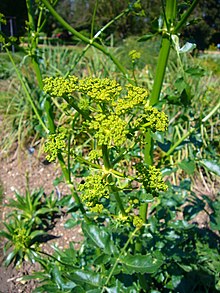Opopanax chironium: Difference between revisions
just a beginning on sorting out this mess; removed cultural references that might not be to this species |
m Dating maintenance tags: {{Cn}} |
||
| Line 27: | Line 27: | ||
|}} |
|}} |
||
'''''Opopanax chironium''''', also known as ''sweet [[myrrh]]'' or ''[[bisabol]] myrrh'', is a [[herb]] that grows one to three feet high and produces a large, [[yellow]] [[inflorescence]]. It is used in the production of certain [[perfumes]].{{cn}} The plant thrives in warm climates like [[Iran]], [[Italy]], [[Greece]], [[Turkey]] and [[Somalia]], but also grows in cooler climates. Some view opopanax grown in cooler climates as being of inferior quality{{Who|date=February 2014}}. |
'''''Opopanax chironium''''', also known as ''sweet [[myrrh]]'' or ''[[bisabol]] myrrh'', is a [[herb]] that grows one to three feet high and produces a large, [[yellow]] [[inflorescence]]. It is used in the production of certain [[perfumes]].{{cn|date=June 2014}} The plant thrives in warm climates like [[Iran]], [[Italy]], [[Greece]], [[Turkey]] and [[Somalia]], but also grows in cooler climates. Some view opopanax grown in cooler climates as being of inferior quality{{Who|date=February 2014}}. |
||
==Uses== |
==Uses== |
||
Revision as of 16:32, 8 June 2014
This article includes a list of general references, but it lacks sufficient corresponding inline citations. (January 2010) |
| Opopanax chironium | |
|---|---|

| |
| Scientific classification | |
| Kingdom: | |
| (unranked): | |
| (unranked): | |
| (unranked): | |
| Order: | |
| Family: | |
| Genus: | |
| Species: | O. chironium
|
| Binomial name | |
| Opopanax chironium W.D.J.Koch
| |
| Synonyms[1] | |
|
List
| |
Opopanax chironium, also known as sweet myrrh or bisabol myrrh, is a herb that grows one to three feet high and produces a large, yellow inflorescence. It is used in the production of certain perfumes.[citation needed] The plant thrives in warm climates like Iran, Italy, Greece, Turkey and Somalia, but also grows in cooler climates. Some view opopanax grown in cooler climates as being of inferior quality[who?].
Uses
A consumable resin can be extracted from opopanax by cutting the plant at the base of a stem and sun-drying the juice that flows out. Though people often find the taste acrid and bitter, the highly flammable resin can be burned as incense to produce a scent somewhat like balsam or lavender. The resin has been used in the treatment of spasms, and, before that, as an emmenagogue, in the treatment of asthma, chronic visceral infections, hysteria and hypochondria. Opopanax resin is most frequently sold in dried irregular pieces, though tear-shaped gems are not uncommon.
The spelling 'opoponax' is also widely used (e.g. in [2]). The OED gives 'opopanax' as the principal spelling, but lists 'opoponax' as a variant spelling recorded from the 19th century.[3]
Etymology
From Anglo-Norman opopanac, from Latin opopanax, from Hellenistic Greek ὀποπάναξ, from Ancient Greek ὀπός ‘vegetable juice’ + πάναξ ‘panacea’ (all healing).[3]
References
- ^ "The Plant List: A Working List of All Plant Species". Retrieved June 8, 2014.
- ^ "Opoponax". Botanical.com. Retrieved 2005-12-15.
- ^ a b "opopanax". Oxford English Dictionary. Retrieved 2009-12-27. (subscription required)
"Opoponax (sweet myrrh)". Scents of the Earth. Retrieved 2005-12-15.
